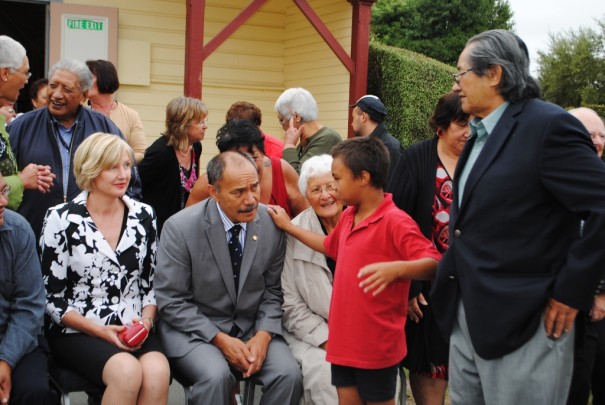Arowhenua Marae

For more photographs, click here.
E ngā rangatira katoa e huihui nei, Ngāi Tahu whānui, e kui mā, e koro mā, tamariki mā, aku mihi māhana, kia ora tātou katoa. Distinguished guests, the kaumātua and kuia of the Ngāi Tahu, tamariki from Arowhenua Māori School, warm greetings to you all.
Thank you for welcoming me, my wife Janine and my party on to Arowhenua Marae this morning as we begin our first official visit to South Canterbury and North Otago. To return your courtesy, it’s probably appropriate that I explain the purpose of our visit drawing on our history.
Over the next few days we will be meeting many different people from many different organisations in South Canterbury and North Otago. We have come to hear of your plans and aspirations for the future.
This is an area of great beauty and while it makes up a relatively small proportion of New Zealand’s population, it contributes much to our nation’s prosperity, through industry, agriculture, trade and business.
Arowhenua Marae is the third Ngāi Tahu marae I have visited, having been welcomed at Rehua Marae in Christchurch in February last year and to Murihiku Marae, near Invercargill, in September last year. Our call here recognises your manawhenua status in this rohe and your place among the runanga of Ngāi Tahu. It acknowledges your resilience, and the place of this marae as a centre of strength for your people and your contribution in the community.
Let me speak briefly of my whakapapa. My heritage is of Te Arawa waka and specifically Ngāti Tūwharetoa. I am also a descendent of Tākitimu waka and Ngāti Kahungunu. My mother’s family had connections to Tūhoe. And my father’s family had connections to Whanganui. I am also a descendent of immigrants who arrived at Wellington, on the sailing ship, Katherine Stewart Forbes, in 1841.
For 38 years I wore with pride the uniform of Ngāti Tūmatauenga—the New Zealand Army. Today, however, I stand as the Governor-General of New Zealand, the representative of Her Majesty, the Queen of New Zealand, and of all New Zealanders.
It was in the name of Her Majesty’s great-great grandmother, Queen Victoria, that my predecessor, Lt Governor William Hobson, signed the Treaty of Waitangi—Te Tiriti o Waitangi with more than 40 rangatira on 6 February 1840. Earlier this month, we marked the 173rd anniversary of the signing of Te Tiriti.
On the basis of a handful of Ngāi Tahu signatures—none of them from this rohe—Hobson’s deputy, Major Thomas Bunbury, claimed sovereignty of the entire South Island. As an aside, it was Bunbury who gained the signature of one of my ancestors, the Ngāti Kahungunu rangatira, Te Hapuku, in June 1840.
In the years that followed many transgressions were committed. Iwi lost their land and suffered great economic, social and cultural hardship. Ngāi Tahu became virtually landless within its rohe. This name of this 108-year-old wharenui, Te Hapa o Niu Tireni, which translates as “New Zealand’s broken promise,” is a poignant reminder of the hardship you endured .
Even so, you retained your mana and you remained steadfast in your call for justice. That commitment was recognised when the Crown signed a Deed of Settlement with Ngāi Tahu to settle your claim. This year is the 15th anniversary of my predecessor, Sir Michael Hardie Boys, giving Royal Assent to the Ngāi Tahu Claims Settlement Act on 1 October 1998.
Since the settlement, Ngāi Tahu has protected and significantly enhanced its putea, and has launched initiatives to regenerate its culture, its language, the health of its people, and the educational opportunities available to them.
Ngāi Tahu has become a fundamental pillar of the cultural, economic and social fabric of the South Island. That has become even more apparent in the aftermath of the earthquakes that have caused so much devastation to Canterbury in the last two years.
Since the settlement, you have been able to invest in your community and to invest in the well-being your people, both young and old. This marae stands proud as a cultural centre and as hub for many services, including Arowhenua Whanau Services He Oranga Pai, which provides primary health care services.
To conclude, I congratulate you on your initiative and your focus on the future. You give real meaning to the vision: “Mō tātou, ā mō kā uri ā muri ake nei—For us and our children after us.” It is a vision for us all. Kia ora huihui tātou katoa.
To listen to the speech, click here.
